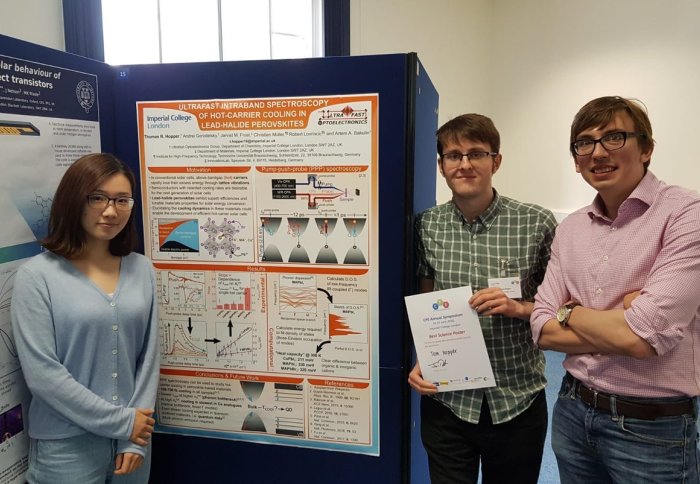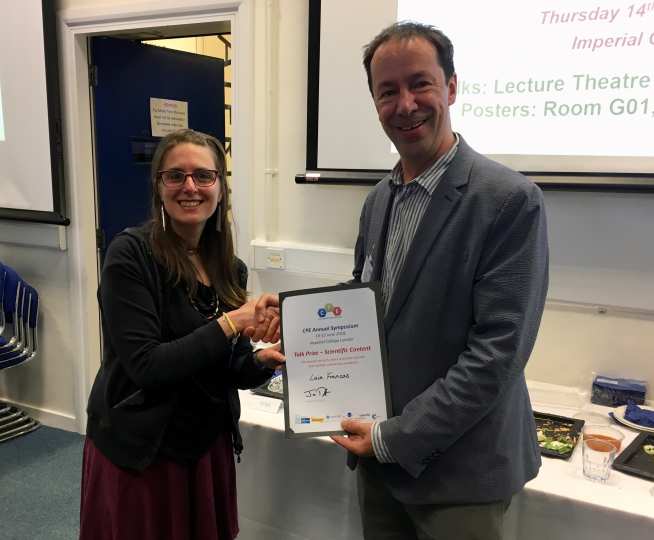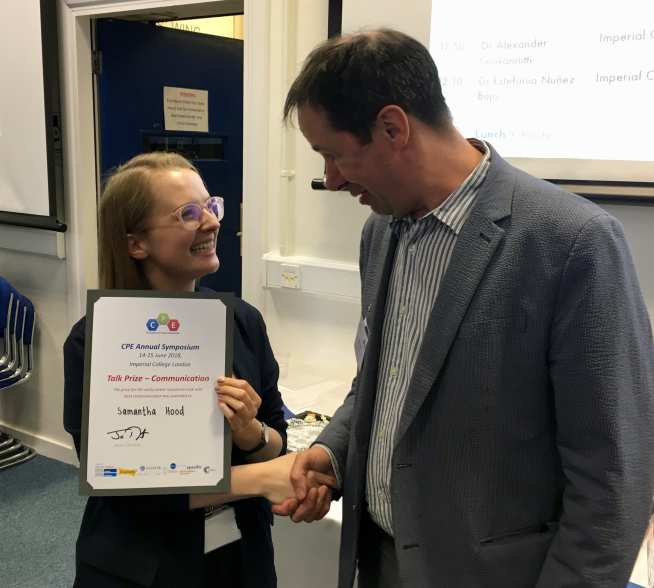

Posters and talks were of a stellar standard at the 2018 CPE Symposium. Our prize winners thoroughly deserved their success.
In the poster categories:
Ryley Ratnasingam (CDT Cohort 7 student) won the Best Communicated Poster prize for his poster "Aerosol Assisted CVD of MAPI for use in photovoltaic applications"
Tom Hopper (CPE PhD student) won the Best Scientific Content in a Poster prize for his poster Ultrafast intraband spectroscopy of hot-carrier cooling in lead-halide perovskites"
Ross Warren (Oxford-based CDT Cohort 7 student) won the Best Designed Poster prize for his poster "Tuning the ambipolar behaviour of organic field electric transistors"
As for the talks...

Laia Francas Forcada presented a comparison between organic-based and inorganic based photocathodes for hydrogen production, highlighting the possibility to use organic systems for solar fuels generation, inspired in organic photovoltaic devices. She demonstrated that in both cases the role of the catalyst was key to successful produce hydrogen. Finally Laia presented some of the work on mechanism studies she has been carrying out on these type of systems over the past few years. Laia won the Best Early-Stage Researcher Talk for Scientific Content Prize.
Laia started as an Associate Researcher in James Durrant's group in 2015, and shortly afterwards was awarded a two years Marie Sk?odowska-Curie fellowship. Her scientific career has focused on solar fuels, which aims at storing solar energy into chemical bonds, as nature does with photosynthesis. To achieve this goal several processes need to take place harmoniously, such as: light absorption, electron extraction from water (water oxidation) and finally fuel generation through reduction of protons or CO2.
Laia's research at Imperial College London is mainly focused on the mechanistic study of the different catalytic reactions involved in the solar fuels production. In-Operando spectro(photo)electrochemistry techniques allow us to shine light into the reaction pathways of different non-ideal metal oxides electrocatalysts or photocatalysts.

Samantha Hood's talk won the Best Early-Stage Researcher Talk for Communication Prize. The talk was about a model she developed during her PhD (at the University of Queensland) to explain how charges can overcome their strong mutual binding in organic solar cells. One of the sources of inspiration for this work was James Durrant’s and Tracey Clarke's 2010 review paper on Charge Photogeneration in Organic Solar Cells.
Due to their disordered structure, charge behaviour in organic solar cells is not well understood, making it difficult to systematically improve device performance. In particular, a vigorous debate surrounds how the positive and negative electric charges overcome their mutual attraction to form an electric current. While charges have been measured to separate with almost perfect efficiency in some materials, it is unclear how they overcome their mutual strong attraction to achieve this so effectively. In typical models, the Coulomb binding between the electron and the hole can exceed the thermal energy kT by an order of magnitude, making it seemingly impossible for the charges to separate before recombining.
In Sam's talk, she described how her model considers the entropic contribution to charge separation in the presence of energetic disorder. She found that even modest amounts of disorder have a decisive effect, reducing the charge-separation barrier to about kT or eliminating it altogether. Therefore, the charges are usually not thermodynamically bound at all and could separate spontaneously if the kinetics otherwise allowed it. Our conclusion holds despite the worst-case assumption of localised, thermalised carriers, and is only strengthened if mechanisms like delocalisation or "hot" states are also present.
Finally, Congratulations to Shenyang Chen, a cohort 7 CDT Incorporated student who won the Best Flash Talk prize.
Article text (excluding photos or graphics) © Imperial College London.
Photos and graphics subject to third party copyright used with permission or © Imperial College London.
Reporter

Lisa Bushby
Department of Physics



